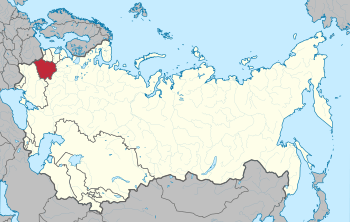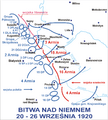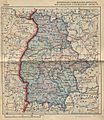Byelorussian Soviet Socialist Republic facts for kids
Quick facts for kids
Byelorussian Soviet Socialist Republic
Russian: Белорусская Советская Социалистическая Республика
Belarusian: Беларуская Савецкая Сацыялістычная Рэспубліка |
|||||||||||||||||||||||||
|---|---|---|---|---|---|---|---|---|---|---|---|---|---|---|---|---|---|---|---|---|---|---|---|---|---|
| 1920–1991 | |||||||||||||||||||||||||
|
Motto: Workers of the world, unite!
|
|||||||||||||||||||||||||
|
Anthem: Anthem of the Byelorussian Soviet Socialist Republic
|
|||||||||||||||||||||||||

Location of Byelorussia (red) within the Soviet Union.
|
|||||||||||||||||||||||||
| Status | Soviet Socialist Republic (1922-1991) | ||||||||||||||||||||||||
| Capital | Minsk | ||||||||||||||||||||||||
| Common languages | Official languages: Byelorussian · Russian Minority languages: Polish · Ukrainian · Yiddish |
||||||||||||||||||||||||
| Government | Unitary Marxist-Leninist one-party Soviet-style socialist republic | ||||||||||||||||||||||||
| First Secretary | |||||||||||||||||||||||||
|
• 1920–1923 (first)
|
Vilgelm Knorinsh | ||||||||||||||||||||||||
|
• 1990–1991 (last)
|
Anatoly Malofeyev | ||||||||||||||||||||||||
| Prime Minister | |||||||||||||||||||||||||
|
• 1920–1924 (first)
|
Alexander Chervyakov | ||||||||||||||||||||||||
|
• 1990–1991 (last)
|
Vyachaslau Kebich | ||||||||||||||||||||||||
| Head of state | |||||||||||||||||||||||||
|
• 1920–1937 (first)
|
Alexander Chervyakov | ||||||||||||||||||||||||
|
• 1990–1991 (last)
|
Mikalay Dzyemyantsyey | ||||||||||||||||||||||||
| Legislature | Congress of Soviets (1920–1938) Supreme Soviet (1938–1991) |
||||||||||||||||||||||||
| Historical era | 20th century | ||||||||||||||||||||||||
|
• Republic declared
|
1 January 1919 | ||||||||||||||||||||||||
|
• Soviet republic proclaimed
|
31 July 1920 | ||||||||||||||||||||||||
|
• Admitted to Soviet Union
|
30 December 1922 | ||||||||||||||||||||||||
|
• Annexation of Western Belarus
|
15 November 1939 | ||||||||||||||||||||||||
| 24 October 1945 | |||||||||||||||||||||||||
|
• Sovereignty declared
|
27 July 1990 | ||||||||||||||||||||||||
|
• Independence declared
|
25 August 1991 | ||||||||||||||||||||||||
|
• Internationally recognized
|
26 December 1991 | ||||||||||||||||||||||||
| Area | |||||||||||||||||||||||||
| 1989 census | 207,600 km2 (80,200 sq mi) | ||||||||||||||||||||||||
| Population | |||||||||||||||||||||||||
|
• 1989 census
|
10199709 | ||||||||||||||||||||||||
| Currency | Soviet ruble (руб) (SUR) | ||||||||||||||||||||||||
| Calling code | 7 015/016/017/02 | ||||||||||||||||||||||||
|
|||||||||||||||||||||||||
| Today part of | |||||||||||||||||||||||||
The Byelorussian Soviet Socialist Republic (BSSR) was a country that existed for most of the 20th century. It was one of the fifteen republics that made up the Soviet Union (USSR). The BSSR was also known as Byelorussia.
In 1922, the BSSR was one of the four original countries that came together to form the Soviet Union. The other founding members were the Ukrainian SSR, the Transcaucasian SFSR, and the Russian Soviet Federative Socialist Republic.
During World War II, Byelorussia was occupied by Nazi Germany. After the war, in 1945, the BSSR became a founding member of the United Nations. This was a big deal because it meant the BSSR had its own voice on the world stage, even though it was part of the Soviet Union.
The BSSR existed until 1991. That year, the Soviet Union broke apart, and Byelorussia became an independent country. It changed its name to the Republic of Belarus. In older times, people in Western Europe sometimes called this area "White Russia."
Contents
What Was the Byelorussian SSR?
The Byelorussian Soviet Socialist Republic was a large country in Eastern Europe. It was located in what is now modern-day Belarus. Its capital city was Minsk.
The BSSR was a "socialist republic." This meant its government followed ideas of socialism and communism. It was a one-party state, meaning only one political party, the Communist Party, was allowed to rule.
Joining the Soviet Union
The BSSR was officially formed in 1920. Just two years later, in December 1922, it joined with other republics to create the Soviet Union. This was a powerful union of socialist states.
For many years, the BSSR was an important part of the USSR. Its people contributed to the Soviet economy and culture. The official languages were Byelorussian and Russian. Other languages like Polish, Ukrainian, and Yiddish were also spoken.
Life During World War II
World War II had a huge impact on the Byelorussian SSR. Nazi Germany invaded the Soviet Union in 1941. Much of Byelorussia was occupied by German forces.
The war caused terrible destruction and loss of life. Many cities and villages were destroyed. After the war ended in 1945, the BSSR began the long process of rebuilding.
Becoming a United Nations Member
Even while it was part of the Soviet Union, the BSSR gained a special role. In 1945, it became one of the founding members of the United Nations. This was a global organization created to promote peace and cooperation.
The BSSR, along with the Ukrainian SSR and the Soviet Union itself, had their own seats at the UN. This gave them a unique presence on the international stage.
From Soviet Republic to Independent Belarus
The Byelorussian SSR existed for over 70 years. But by the late 1980s, the Soviet Union began to face many challenges. People wanted more freedom and changes in how the country was run.
On July 27, 1990, the BSSR declared its sovereignty. This meant it claimed the right to govern itself. Then, on August 25, 1991, it declared full independence.
The Soviet Union officially ended in December 1991. The Byelorussian SSR was no more. It was replaced by the independent Republic of Belarus. This new country was recognized by other nations around the world.
Everyday Life and Culture
Life in the Byelorussian SSR was shaped by its socialist system. The government controlled many aspects of daily life. People worked in factories, farms, and other state-run organizations.
Despite the political system, people maintained their unique culture. Traditional Belarusian customs and foods were important. For example, draniki, which are potato pancakes, are a popular national dish.
The capital city, Minsk, grew and developed over the years. It became a center for industry and education. The railway station in Minsk, even in the 1920s, showed the mix of languages spoken there.
Images for kids
-
After the decisive Polish victory in Warsaw, the Red Army was forced to retreat from Polish territories, but attempts to hold Western Belarus were lost after the Polish victory on the Nieman River.
-
Russia-born Andrei Gromyko (right) served as Soviet foreign minister (1957–1985) and as Chairman of the Presidium of the Supreme Soviet (1985–1988)
-
Draniki, the national dish
See also
 In Spanish: República Socialista Soviética de Bielorrusia para niños
In Spanish: República Socialista Soviética de Bielorrusia para niños












